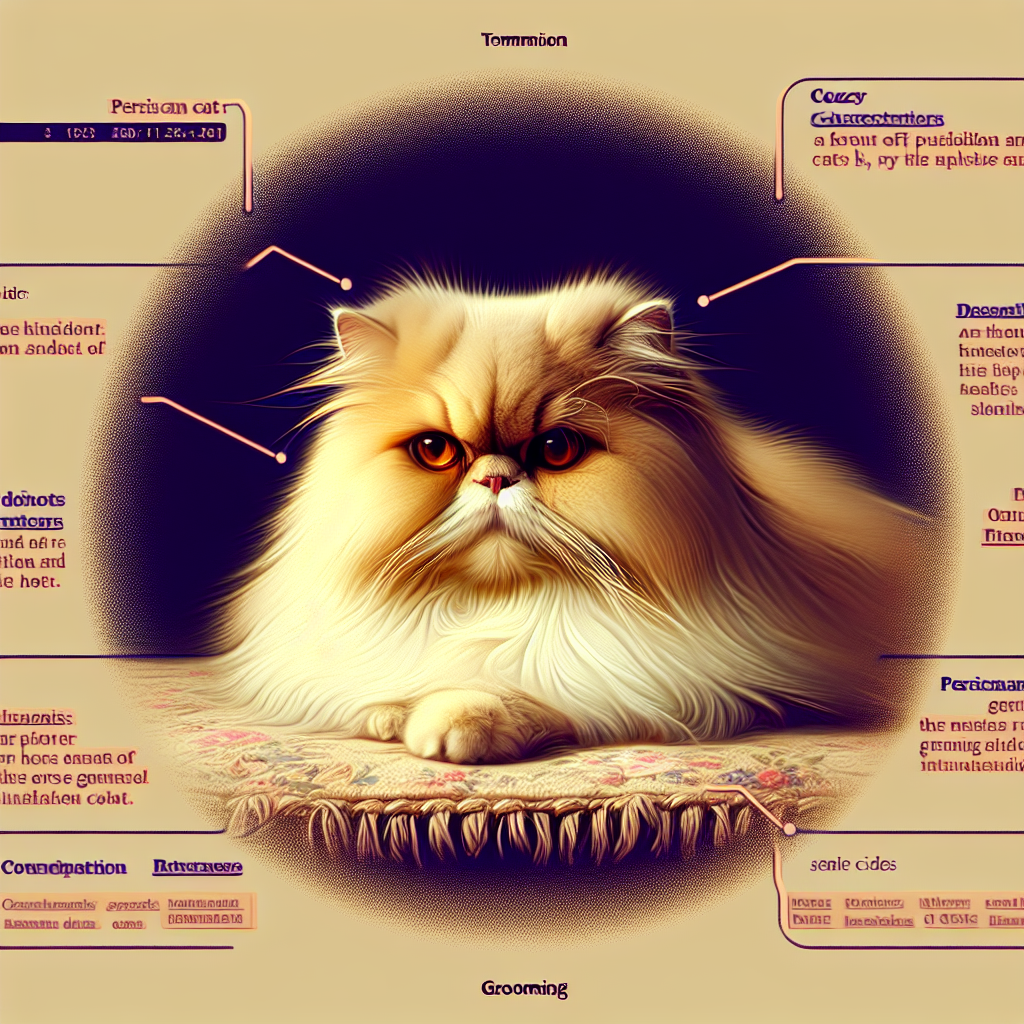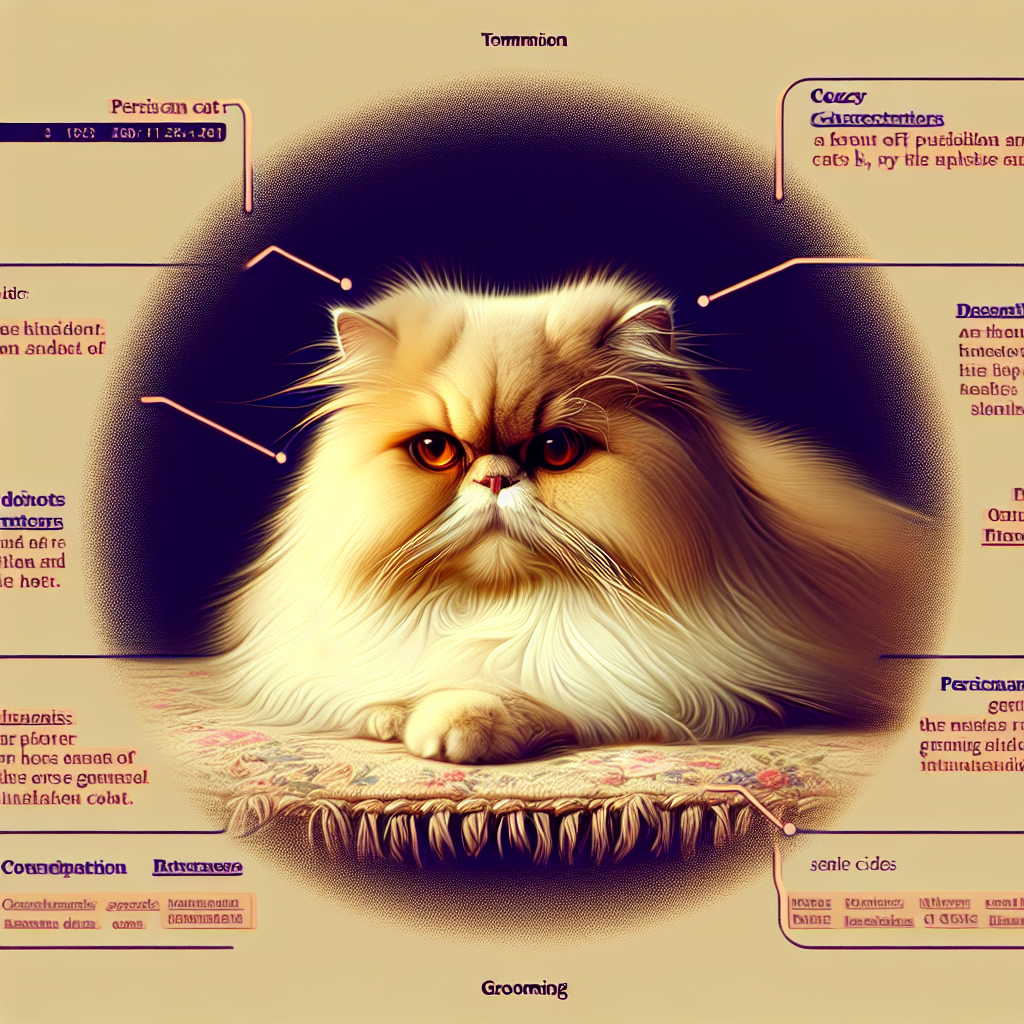If you’ve ever wondered what makes a Persian cat so unique, look no further. This article is here to provide you with all the essential information you need to know about these delightful felines. From their luxurious long fur to their sweet and gentle temperament, Persian cats have captured the hearts of many cat enthusiasts around the world. Let’s uncover the fascinating world of Persian cats together, exploring their origins, notable features, and the care they require to thrive as beloved pets.
Physical Appearance
Distinctive Features
Persian cats are known for their distinct appearance, which sets them apart from other breeds. One of the most prominent features of a Persian cat is its beautiful, long, flowing coat. Their luxurious fur is dense and requires regular grooming to keep it looking its best. Another distinctive feature of Persian cats is their round faces and large, expressive eyes. Their noses are short and wide, adding to their adorable and charming look.
Coat Varieties
Persian cats come in a variety of coat colors and patterns, offering a wide array of choices for potential owners. They can have solid colors such as white, black, or cream, or they can be a combination of different shades. Persian cats can also have patterns like tortoiseshell, tabby, or colorpoint. Each coat variety possesses its own unique charm and can enhance the overall beauty of the cat.
Facial Structure
One of the most endearing aspects of Persian cats is their facial structure. Their round faces give them a sweet and innocent expression, which is further accentuated by their large, round eyes. Their cheeks are full, and their small, upturned noses add to their overall cuteness. This facial structure is a characteristic trait of Persian cats and contributes to their undeniable charm.
Temperament
Gentle and Affectionate
Persian cats are renowned for their gentle and affectionate nature. They are known to be calm and laid-back, making them perfect companions for those seeking a serene and peaceful feline friend. Persians are often content with lounging around and enjoying a cozy spot by your side. They have a soft, sweet disposition and thrive on love and attention from their human companions.
Reserved and Independent
While Persian cats are generally gentle and affectionate, they can also have a reserved and independent side. They may prefer to have their alone time and enjoy quiet moments to themselves. This independent nature means that they can entertain themselves and are often content with their own company. However, they still cherish the love and companionship of their owners and appreciate affectionate gestures.
Adaptable and Relaxed
Persian cats are known for their adaptable nature, making them well-suited for various living environments. They can thrive in both apartments and houses, as long as they are provided with a comfortable and calm space. These cats are generally relaxed and tranquil, able to adjust to different routines and schedules. With a little bit of personal space and lots of love, Persian cats can adapt to any loving home.

Grooming Needs
Daily Brushing
Due to their long and luxurious coats, Persian cats require regular grooming to keep their fur healthy and free of tangles and matting. Daily brushing is recommended to prevent knots from forming and to keep their fur looking its best. Brushing also helps to remove loose hair and reduces the occurrence of hairballs. This grooming routine not only keeps your Persian cat looking beautiful but also strengthens the bond between you and your furry friend.
Regular Bathing
In addition to daily brushing, Persian cats benefit from regular bathing to keep their coats clean and free from dirt and oils. It is important to use cat-specific shampoos and products while grooming your Persian cat to avoid skin irritations and allergies. However, it is crucial to keep in mind that excessive bathing can strip their fur of essential oils, so it is essential to strike a balance to maintain their coat health.
Eye and Nose Cleaning
Persian cats have beautiful, expressive eyes, but they are also prone to tear stains. Regular cleaning of their eyes with a damp cloth or gentle eye wipes can help keep tear stains to a minimum. Additionally, their short noses may need occasional cleaning to remove any accumulated dirt. These simple grooming practices are crucial to maintaining your Persian cat’s overall health and well-being.
Health and Care
Potential Health Issues
While Persian cats are generally healthy cats, they are prone to certain health issues that potential owners should be aware of. Common health problems in Persian cats include respiratory issues due to their facial structure, dental issues, and kidney problems. Regular veterinary check-ups and a healthy lifestyle can help minimize the risk of these health concerns and ensure your Persian cat leads a happy and healthy life.
Veterinary Care
To keep your Persian cat in optimal health, regular veterinary care is essential. Routine check-ups, vaccinations, and preventive treatments are important for detecting and addressing any health issues at an early stage. Be sure to find a veterinarian experienced with Persian cats who can provide personalized care based on their unique needs. Regular veterinary care, combined with a nutritious diet and exercise, can contribute to a long and happy life for your feline companion.
Proper Nutrition
Proper nutrition plays a vital role in the overall health and well-being of Persian cats. It is essential to provide a balanced diet that meets their specific nutritional requirements. High-quality cat food, either commercially prepared or homemade, should include a combination of protein, healthy fats, vitamins, and minerals. Additionally, ensuring your Persian cat receives an adequate amount of fresh water daily is crucial for preventing dehydration and promoting their overall health.

Living Environment
Indoor vs Outdoor
Persian cats are generally better suited to an indoor living environment. Their long coats are susceptible to tangles and can become dirty if they spend too much time outdoors. Furthermore, Persian cats may be more prone to certain health hazards if they roam freely outside, such as exposure to parasites and potential injuries from accidents. An indoor environment allows you to create a safe and controlled space for your Persian cat to thrive.
Spacious and Quiet Space
Persian cats appreciate having a spacious and quiet living environment that allows them to relax and enjoy their surroundings. They enjoy having their own little nooks and crannies to explore and retreat to when they need some alone time. Providing cozy beds, scratching posts, and vertical spaces for climbing can help create a comfortable and stimulating environment for your Persian cat.
Safety Considerations
As a responsible Persian cat owner, it is essential to ensure your home is safe and cat-proofed. Keep harmful substances out of reach, secure windows and balconies, and remove any potential hazards such as small objects or toxic plants. Additionally, it is important to supervise your Persian cat when they have access to other parts of your home to prevent any accidental mishaps. By implementing these safety considerations, you can provide a secure and protected living environment for your feline companion.
Training and Exercise
Litter Box Training
Litter box training is an important aspect of owning a Persian cat. These cats are naturally tidy and clean, so they generally take to litter box training quite easily. Ensure that you provide a clean litter box in a quiet and accessible location. It is recommended to scoop the litter box daily and change the litter regularly to maintain hygiene. Positive reinforcement, such as praise or treats, can also be used to encourage proper litter box habits.
Positive Reinforcement
Persian cats respond well to positive reinforcement during training. Rewarding good behavior with treats, praise, or playtime can be highly effective in motivating them to repeat desired actions. Avoid using punishment or harsh training methods, as it can lead to fear or anxiety in these sensitive cats. With patience, consistency, and positive reinforcement, you can train your Persian cat to exhibit desirable behaviors and strengthen your bond with them.
Mental Stimulation
While Persian cats may have a laid-back temperament, mental stimulation is still important for their overall well-being and happiness. Engaging them in interactive play sessions with toys, providing scratching posts, and introducing puzzle toys can help keep their minds sharp and their energy levels balanced. It is important to keep their environment enriching and provide opportunities for them to engage in natural feline behaviors, such as climbing, scratching, and hunting.
Compatibility with Children and Pets
Interaction with Children
Persian cats are generally tolerant and gentle, making them suitable companions for families with children. However, it is important to teach children how to interact respectfully and gently with cats to prevent any accidental harm. Supervision is key, especially with younger children, to ensure that both the children and the cats feel safe and comfortable during their interactions. By fostering a positive and gentle environment, Persian cats can form strong bonds with children and become cherished members of the family.
Getting Along with Other Pets
While Persian cats can be amiable and get along well with other pets, proper introductions and gradual acclimation are crucial when bringing a new pet into the household. It is important to provide separate spaces and initial supervision to allow all pets to adjust and become acquainted with one another’s scent and presence. With patience and proper introductions, Persian cats can form harmonious relationships with dogs, other cats, and even smaller pets such as rabbits or guinea pigs.
Supervision and Teaching
When integrating a Persian cat into a household with children or other pets, it is necessary to provide supervision and guidance. Teaching proper handling techniques and ensuring gentle interactions will help prevent any accidental harm to both the cat and the other individuals. It is important to monitor their interactions and intervene if needed, ensuring that everyone feels safe and comfortable. With consistent guidance and supervision, Persian cats can thrive in a multi-pet household.
Common Misconceptions
Maintenance-Free Pets
It is a common misconception that Persian cats require minimal grooming due to their sedentary nature. While they may not be as active as some other breeds, their long fur necessitates regular maintenance and grooming. Neglecting their grooming needs can lead to matting, skin issues, and discomfort for the cat. Regular grooming sessions and daily upkeep are essential to keep their coat healthy and prevent any potential health problems.
Hypoallergenic Breed
Contrary to popular belief, Persian cats are not considered hypoallergenic. While they may produce fewer allergens than some other breeds, they still produce allergenic proteins that can trigger allergies in sensitive individuals. Before bringing a Persian cat into your home, it is important to spend time with them to see if you have any adverse reactions. Regular cleaning, maintaining good indoor air quality, and minimizing exposure to allergens can help manage allergies associated with Persian cats.
Easy Breathing
Due to their facial structure, Persian cats may experience breathing difficulties or be prone to respiratory issues. Their short, flattened noses and long, soft palates can result in snoring or noisy breathing. It is important to be aware of these potential issues and provide a healthy environment with good air quality for your Persian cat. Regular veterinary check-ups can help detect and address any respiratory concerns early on.
Adoption and Purchase
Rescue Organizations
Adopting a Persian cat from a rescue organization can be a fulfilling and compassionate choice. Rescue organizations often have a variety of Persian cats available for adoption, and they can provide you with all the necessary information about a cat’s history and temperament. By adopting, you are giving a loving home to a cat in need and potentially saving a life. Research local rescue organizations, visit their facilities, and inquire about the adoption process to find your perfect Persian companion.
Registered Breeders
If you prefer to purchase a Persian cat from a breeder, it is important to choose a reputable and responsible breeder. Registered breeders adhere to strict breeding practices, prioritize the health and well-being of their cats, and provide proper documentation for their kittens. Research breeders thoroughly, ask for references, and visit their facilities to ensure they are ethical and provide a supportive environment for their cats.
Budgeting for a Persian Cat
Owning a Persian cat comes with financial responsibilities. In addition to the initial adoption or purchase cost, you should budget for their ongoing care. This includes expenses such as high-quality food, grooming supplies, veterinary visits, vaccinations, and preventive treatments. Additionally, it is wise to have a contingency fund for unexpected veterinary expenses. By responsibly budgeting for your Persian cat’s needs, you can ensure they receive the care they deserve throughout their lives.
Persian Cat Show
Show Standards
Persian cat shows are a wonderful opportunity to showcase the breed’s unique qualities. Different cat associations may have slightly varying show standards, but generally, Persian cats are judged based on their overall appearance, including coat quality, eye color, and facial structure. Judges also evaluate the cat’s temperaments and behavior during the show. Understanding the specific show standards of the organization you choose to participate in is vital when preparing your Persian cat for the show ring.
Judging Criteria
During a Persian cat show, judges assess various aspects of the cat’s appearance and behavior. They evaluate the cat’s head and face, coat texture and grooming, body type, eye color, and overall condition. Temperament also plays a role in the judging, as judges look for cats that display calm and poised behavior. Understanding the specific judging criteria of a show can help you prepare your cat and ensure they are presented in the best possible light.
Participation Guide
Participating in a Persian cat show requires thorough preparation and attention to detail. It is essential to read the show rules and regulations provided by the organizing association to understand the requirements and guidelines. This includes specific grooming standards, breed-specific rules, and documentation needs. Familiarize yourself with the various categories and classes offered in the show, and consult experienced exhibitors or breeders for guidance. Preparing your Persian cat for a show can be an exciting journey that showcases their beauty and temperament to a broader audience.
In conclusion, Persian cats are extraordinary feline companions known for their distinctive appearance and gentle nature. They require regular grooming to maintain their beautiful coats and benefit from a calm and spacious living environment. With proper nutrition, regular veterinary care, and positive training techniques, Persian cats can live healthy and happy lives. Whether adopting from a rescue organization or purchasing from a reputable breeder, bringing a Persian cat into your home requires dedication, patience, and love. And if you choose to embark on the exciting adventure of participating in a Persian cat show, thorough preparation and understanding of the show standards are key. So, if you’re looking for a loving and elegant feline companion, a Persian cat may be the perfect addition to your home.

